Sex in
Early American Music
7/2011 Vautier
You may tempt the upper classes
With your villainous demitasses[1]
But heaven will protect a working
girl.[2]
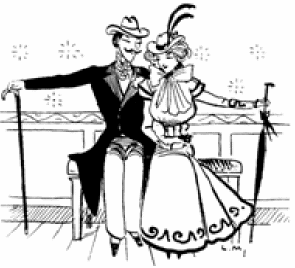 There is a misconception about that
period of time called the “gay nineties,” an apparently
joyous, light-hearted interlude from 1890 until 1910. In our minds’ eyes we see images of Victorian reserve and
emotional restraint, young ladies strolling in the sunlit park with
parasols in hand accompanied by handsome well-behaved beaus, properly
attired in well-groomed mustache and boater hat. In the cool evenings, moonbeams and soft starlight flicker
through the trees amid canoe rides and tender kisses.
The scent of fresh roses arise in the air, all the while
brass bands and roving quartets create sweet harmonies and rapturous
melodies:
There is a misconception about that
period of time called the “gay nineties,” an apparently
joyous, light-hearted interlude from 1890 until 1910. In our minds’ eyes we see images of Victorian reserve and
emotional restraint, young ladies strolling in the sunlit park with
parasols in hand accompanied by handsome well-behaved beaus, properly
attired in well-groomed mustache and boater hat. In the cool evenings, moonbeams and soft starlight flicker
through the trees amid canoe rides and tender kisses.
The scent of fresh roses arise in the air, all the while
brass bands and roving quartets create sweet harmonies and rapturous
melodies:
I dream of Jeanie with the light
brown hair,
Borne like a vapor on the summer air.[3]
These
aesthetic images give us a distorted picture. We like to think that
there was a lot of flowery romance in the air, and it well may have been
so. But the thing we know
for sure is a lot of sex was definitely going onRecords show us that this period had a significantly higher
unmarried birthrate then any time before or since.
... one suggestive piece of evidence
is the change in the rate of premarital pregnancies. Having fallen to a low of ten-percent in the mid-nineteenth
century, the rate rose significantly to twenty-three percent in the
decades from 1880 to 1910.[4]
 This
means simply lots of sex. Until 1950, the ratio between the frequency of premarital sexual
activity and the number of illegitimate offspring had not changed very
much. At that point,
effective birth control--the pill--took over the task of regulating baby
production, affecting the long-standing statistical relationship between
premarital sexual activity and illegitimate births. Using this ratio, we can be pretty certain that more sex and free love
occurred around the turn
of the twentieth century than at any other period before 1950.
This
means simply lots of sex. Until 1950, the ratio between the frequency of premarital sexual
activity and the number of illegitimate offspring had not changed very
much. At that point,
effective birth control--the pill--took over the task of regulating baby
production, affecting the long-standing statistical relationship between
premarital sexual activity and illegitimate births. Using this ratio, we can be pretty certain that more sex and free love
occurred around the turn
of the twentieth century than at any other period before 1950.
So why are the 1890’s looked upon
as an era of sexual restraint? Probably because that's what the upper class wanted everybody to believe.
The upper class, where most of the wealth was concentrated, controlled newspapers, railroads, steel
production, coal mining, and most industries. This group of people had it in their interest that America
was to be viewed as following a path of moral righteousness. Regardless of the facts, that’s the way they wanted it to be,
so that's the way it was going to look in newspapers and
history books!
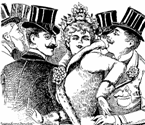 Just
about everything that was advertised to a fast-emerging middle class
from above demanded sexual restraint. This included dress, manners, public
comportment, social habits, boy-girl relationships, and the use of
chaperones. Ladies could not
expose even their ankles for fear of stirring passions and arousing carnal urges of
young men. The words “leg,” “breast,” “belly,” “woman,” and
other anatomically suggestive words were banished from polite
conversation. Other more
“suitable” words were used, such as lady or girl. Chicken had white meat instead of breast meat, dark meat instead
of legs.[5]
In short, any word that hinted of a body part was not
spoken in public nor in the presence of the impressionable, naïve, and
easily beguiled “tender sex.” Such
breaches of propriety were considered rude, crass, boorish,
and unacceptable. This
was the specific intent of the upper class and clergy, from which we get our
current and perhaps incorrect view of these times.
Just
about everything that was advertised to a fast-emerging middle class
from above demanded sexual restraint. This included dress, manners, public
comportment, social habits, boy-girl relationships, and the use of
chaperones. Ladies could not
expose even their ankles for fear of stirring passions and arousing carnal urges of
young men. The words “leg,” “breast,” “belly,” “woman,” and
other anatomically suggestive words were banished from polite
conversation. Other more
“suitable” words were used, such as lady or girl. Chicken had white meat instead of breast meat, dark meat instead
of legs.[5]
In short, any word that hinted of a body part was not
spoken in public nor in the presence of the impressionable, naïve, and
easily beguiled “tender sex.” Such
breaches of propriety were considered rude, crass, boorish,
and unacceptable. This
was the specific intent of the upper class and clergy, from which we get our
current and perhaps incorrect view of these times.
The
majority of popular music written before 1892 did not seem to hint at the
idea of physical sex or even physical contact because sex at that
earlier time
was not a publishable commodity. It
was instead a non-entity in the Victorian court of impeccably pure
standards and unimpeachable moral correctness. This included such topics as kissing, caressing, hugging,
petting, or anything whatever to do with physical contact. The “I” word (it) was a marginally acceptable substitute for
the word sex, and even it had to be
handled carefully.[6]
In biblical lore, Jehovah was
a substitute for Yahweh
because God’s name was much too holy to be spoken in common. Anyone who dared utter the holy name of God stood the risk of
being immediately struck dead by a thunderbolt from on high. A similar dreadful fate was sure to await anyone so bold as to
utter that most sacred of words, sex, in public or in mixed company.
Up until 1892 general song topics
included lost or dead kids, drinking, sailing, mocking birds,
sunsets, fights between big Irishmen, growing old,
mothers, marching off to war, religious emotion, and a hundred other things, but no really
interesting sex, romance, or love. If
the theme was one of love, it was handled very carefully. All suggestive or ambiguous words were avoided.
Therefore the musical period before
1892 is quite remarkable for its lack of sexual remarkability. No mention of tender loves, spicy escapades, illicit
romances, elopements, “fallen ladies,” or “wilted flowers.”
Nor were there discussions of rowing up the river with a girl, hugging
in movie houses, kissing under the moon, caressing in the park, loving,
spooning, or romancing. Nothing
more than blithe birds and sweet butterflies appeared in song lyrics.
Indeed a menagerie of other topics were around but there was no
sex. “Sweetheart”
was about as close as one dared come to the forbidden topic. Below is an example of one really red-hot love song from this
period before 1892:
I’ll take you home again Cathleen,
Across the ocean wild and wide.
To where your heart has never been,
Since first you were my bonnie bride.[7]
No sweetie-pie, ladylove, girlie, honey-bunch, gal,
hootchy-kootchy, tootsie-wootsie, turtledove, honey-bunny or ragtime
gal. Not even so much as a
soft, little, innocent sweetheart. But by 1892 the music kettle
was at a rolling boil. Love
and sex were just bubbling to get out, and it all seems to have started
in vaudeville.
Vaudeville
Vaudeville was a type of non-stop,
low-humor variety-stage entertainment featuring songs, dances,
burlesques, skits, monologues, jugglers, acrobats, animal acts, singers,
strong men, magicians, chorus girls, and slapstick. You name it, vaudeville did it.
The format was open in structure and usually consisted of nine acts
per show, each show lasting a little more than about two hours.
Common wisdom has it that Vaudeville
began around 1880 as a response to other forms of entertainment, or
perhaps because a lot of the bars, saloons, and brothels were losing
clientele to local theaters. This
explanation does not really make sense since those places always had plenty
of business if they were well run; and besides, the theaters did not
serve whisky, beer, and other amenities, so they weren’t actually
competing for the same clientele. True,
there was competition, but only between the individual bars and saloons.
It is probably more accurate to say
that Vaudeville was simply an outgrowth of the brothels. In 1880 a brothel was not exclusively a site for sexual activity
but a place of general
entertainment, . The patrons enjoyed beer, alcohol, burlesque, skits, dancing, and of course, available women.
Vaudeville sprang out of this arrangement most likely because it
was free of the usual forms of censorship. The morally upright and socially conscious upper-class and clergy
had for many years been dictating and administering morality through
their powerful influence over law enforcement, religion, politics, and
the press. However, because
Vaudeville was hiding behind the kind of low-end social shield that
allowed such activities to develop independent of mainstream life, it
was able to fill the obvious vacuum that Victorian morality had created.
Owners of the saloons and brothels had an understanding with
authorities that performances of questionable character were to be
permitted and even expected, but only within certain limits (e.g. girls
had to wear tights, no physical contact with customers). Therefore, unimpeded by the social control and moral
strictures that late nineteenth-century society imposed on general
entertainment, vaudeville developed a much richer and more original type
of artistic expression.
Tony
Pastor
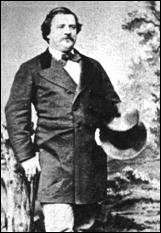
Vaudeville gradually broke away from
the bars and brothels, moving into its own theaters and forming business
affiliations. Several large
syndicates were developed that owned and operated vaudeville theaters in
many cities. These theaters
rotated their performances from one city to another, and the whole
arrangement soon became a very profitable enterprise. Many good Hollywood
performers matured by developing their talents precisely in this
environment.
Vaudeville thrived on sexual
innuendo, double meanings, and even clearly sexual music, a type of
behavior sure to constantly attracted big crowds. The theaters of Tony Pastor and Koster and Bials usually played
to packed houses while openly flaunting their full-figured and buxom
chorus girls, exhibiting every bit of bad taste and roguery that society
then would allow. They
even occasionally attempted strip shows in which the girls, of course,
could strip no further than to their flesh-colored tights. It was a bold time and all of it great fun for the
teaming crowds. Occasionally
such depravity did bring in the law--at prearranged times, of course,
and primarily to pay feigned homage to the ever-vigilant moral
reactionaries. The raids
also were good for business because they provided free, sometimes
front-page advertising.
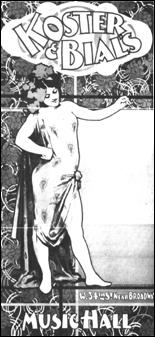
Erotic songs abounded in vaudeville.
It was a main breeding ground for the objectionable, the
tantalizing, the suggestive, and always the slightly obscene. It was a test site for racy material, new and old alike.
It pushed the limits of decency. If you could get away with it in vaudeville, you may be able to
do it on Broadway. If you
could do it on Broadway, you may be able to publish it as popular sheet
music. Such was the
progression. Broadway looked
to vaudeville as a moral temperature gauge, and so did the music
publishing houses in general. Good
songs done on the vaudeville circuit could be watered down a bit. Then these
songs could perhaps be worked into a Broadway musical and, even more
often, sold to one of the many interested publishing houses for release to
the general public.
Other vaudeville songs, such as Pump Away Joseph, were just too far beyond the pale to make it
anywhere out
of the Tenderloin or the Bowery. This
song’s obvious reference to sex had the audiences rolling in the
aisles, and many young women hiding their embarrassment behind fans and
shawls.
Pump away Joseph, do;
Pump away Joseph, do.
Be ready and willing, the kettle be
filling,
While I make tea for two.
Get there Joseph, do.
Some day I’ll pump for you.
Don’t stay there and dandle,
But collar the handle,
And pump away, Joseph, do.[8]
The public, usually young people,
loved these songs, and continued to fill the vaudeville houses in New York,
Philadelphia,
Chicago,
Boston, and other cities on the vaudeville circuit. The suggestive lyrics, the scanty costumes, the burlesque dances,
and the general air of seediness were all part of the show.
Many fine
female singers made their living and earned their fame on the vaudeville stage.
These included the irresistible Lillian Russell, the magnetic Nora
Bayes, the innocent Maude Nugent, the mesmerizing Blanche Ring, the sexy
Eva Tanguay, and the evocative Anna Held. The four famous female baritones,[9]
Lottie Gilson, Imogene Comer, Maggie Cline and Helene Mora popularized songs with their over-done, suggestive, and
raspy
singing styles. Then, too were the “coon shouters” like May
Irwin [52], whose exaggerated
style of delivery was not a whole lot different from modern rap. It was through the efforts of these singers that vaudeville
became a powerful source of this more physical and expressive type of
music that would eventually have a decided influence on the mainstream.
When popular music burgeoned in 1892
and afterwards, much of the vaudeville material
automatically began to move in that direction. Tin Pan Alley enthusiastically promoted these hot songs, much
to the chagrin and displeasure of social lions. The respectable upper class felt that these songwriters had a
moral obligation to resist the lure of profits by restraining from
offering material of morally questionable content. After
all these songwriters had no business spreading the evil and
turpitude of vaudeville beyond those clearly designated locations for such
sin and degradation. If
there had to be evil in the world then let it remain restricted to where
the pillars of society wanted it to be confined. After all these people felt they were the administrators of
morality.
In addition the new songs started
popularizing the more undesirable and offensive slang that was usually
only heard on the lusty stages of vaudeville and in the scruffier parts
of town reserved for these theaters and places of ill fortune and
depravity. The songs brought
into frequent use such casual and sexually degrading words as gal,
ragtime gal, sweetie pie, tender love, ladylove, doll, corker, girly,
babe, baby, fast girl, warm girl, hootchy-kootchy, and a host of
other new phrases. It became
so bad that even teenagers began communicating in these ways. We can well imagine the shame and embarrassment of parents when
they overheard their own children using words like baby,
sweetie pie, and even worse,
warm girl, hootchy-kootchy, or corker.
Vaudeville offered to many a first
glance at the beauty of sex. There
were young ladies in circus costumes who performed acrobatic tricks on
stage, while others, on tightropes and high wires, stripped to
flesh-colored tights to the sound of bump and grind music. Still others cavorted around on stage, wearing the flimsiest of
attire, belting out suggestive, outrageous, and in every way unladylike
songs. All this took place
in front of wide-eyed, open-mouthed, impressionable young people. Scandalous!
Absolutely
scandalous! And what’s
more, the boisterous performances of those female baritones and “coon
shouters” absolutely intoxicated audiences. They employed highly suggestive styles and mannerisms, spicy
monologues between
song verses, and foxy, coquettish, and shameful on-stage antics. Indeed their behavior was anything but proper or befitting of the
“fair sex.”
Lottie Gilson
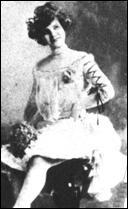
Here is an example of one of these spoken monologues, done by Lottie
Gilson between the verses of You
Don’t Have to Marry the Girl. The orchestra becomes quiet while floodlights train in on a
diminutive five-foot-two-inch figure at center stage. Wearing a bright-colored, loose, plunging camisole and a short,
flouncy dress with tights and sporting an immense ostrich-plumed hat,
she speaks:
… In two minutes she’ll be
calling you Algie again, the same as ever with a look in her eyes that
says, “Kiss me just once and save my life!” So you kiss her. Then you kiss her again.
And
the more you do it the better she likes it, and the better you like her.[10]
The vaudeville machinery continued to
yield up a good number of songs for the mainstream, that is of course,
after cleaning them up for general consumption. But even after sanitizing the words, strong sexual themes
remained. This unique blend
of low humor and sexuality offered a refreshing light in the darkness of
these times.
In 1908 a righteousness began to
overtake vaudeville. It
was losing its audience and had to draw people back mainly by improving
upon its former shabbier image. Suddenly,
gone were the seedy acts, the ambiguous sexual innuendoes, the female
baritones, and scantily clad girls. Back came the monologues, jugglers, acrobats, slapstick, animal
acts, strongmen, and magicians. Vaudeville
wanted to appeal to a larger segment of the public by casting off its
older, darker image in order to qualify as clean, respectable family entertainment.
Some
of this reform movement was no doubt due to the unremitting conservative
backlash, the constant nagging of moralists and clergy, and renewed
efforts by law enforcement and women’s groups, all demanding reform.
Mostly, however, it was just a way to bring back the crowds,
because the audiences had begun to dwindle, siphoned away by the
ever-increasing forms of alternative entertainment like nickelodeons,
arcades, amusement parks, and moving pictures.
All the same, it was a losing cause.
The audiences continued to diminish until, by 1930, most of
vaudeville had moved to Hollywood. Gone were the slapstick
and comedy acts, the punching, slapping, and poking. Gone too were the often obnoxious and boisterous crowds.
Also gone from the stage was the strong scent of greasepaint
mixed with tobacco and many other smells. No longer noticeable was the odor of girls sweating under the
heat of powerful low lights or the stale but distinct gymnasium smell
that seamed to constantly permeate the air, a telltale reminder of a
thousand past performances past and future. No
longer heard was the saucy and vibrant music interwoven with suggestive
dialogue and nonverbal queues. Missing
were the asides, the winks, gestures, hip movements and nods. These had all gone west to the silver screen.
Nonetheless, the legacy of vaudeville
remained. It remained that
valuable link between the fashionable and the risqué, the other side of
the social coin, the other world, the demimonde.
It was a contrast between what was strictly proper and what was
deliciously tainted, the rigidly acceptable and the slightly sleazy.
It was the pressure gauge, the relief valve. It was that shadow moral government that allowed freedom of
expression in a society that had become polarized in an
era where even the word sex
had been stricken from the lexicon. People lived in a fairy-tale world where storks delivered babies,
masturbation caused blindness, and menstruation was a punishment sent
from heaven. The “s” and
“i” words (sex and it)
were only talked about in whispers and innuendoes. But through all this righteous smoke vaudeville had
remained the only thing to remind us that life could be better
and that it was still fun to be human.
The Revue
Ziegfield
girl 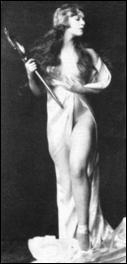
As
vaudeville began to fade its sexual themes were replaced
by the revue, which was essentially an updated form of the early
extravaganza. The revue had
more girls, more songs, more pageantry, larger stages, bigger sets, and
cheaper, flimsier music. All
this was spearheaded by the greatest of the original playboys, Florenz
Ziegfield.
Florenz was the first of the great
flesh peddlers. Long before
porno flicks and cyber chicks and long before Hugh Hefner, Bob
Guccioni, and Larry Flint, Florenz Ziegfield made his mark and his
fortune riding high on the substantial hips and proportionally
substantial bosoms of beautiful young girls. Flo set the definition for the large theatrical revue, featuring
many scantily adorned young beauties in stage shows that were rich
in pomp and poor in composition or real musical substance. Still it sold to packed houses.
Florenz did not care about the quality of the music. People
wanted cheap sex shows in the exalted name of French class, although his
revues had little French and less class.
Nevertheless America was ready for Flo’s shows after enduring years of
starved psyches and undernourished libidos. The Ziegfield Follies granted a respite, a refreshing plunge into
the early 2000's sex exploitation, after a long period in the dry desert of sexual
denial.
The revue was based on a tradition
dating back probably to 1867 when The
Black Crook first opened. The Black Crook
is
more properly considered an extravaganza. It was a progression of on-stage pageants featuring lots of
chorus girls wearing few clothes, which was held together by an
even more frivolous and contrived plot. The music was highly forgettable.
Still, The Black Crook was
definitely the first stage play to in any way resemble an American musical, despite
its main intent to show off leggy, full-figured women in tights under
the presumption of “wholesome and socially redeeming art.” Obviously, the revue was not exactly new.
What was new, however, was the way Ziegfield was able to promote
his product.
As a young boy, Flo rebelled against
almost anything Victorian. Born
into a middle class
Midwest
family, he had been forced to accept traditional moral values. He became determined to reject these same values outright, make
his own way, and live his life free of the chains and limitations of a
society which he felt had gotten way out of control. So he did.
While on a business trip to London, he fell deeply in love with the beautiful and talented singer Anna
Held. They proceeded to live
together in unmarried bliss for several years, which, although quite
scandalous, only served to enhance Flo’s soaring reputation as a
first-rate playboy. He
thrived on scandal.
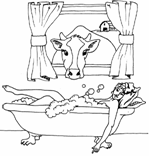 By
1896 Anna Held hit upon fame in her own right with several songs. Still, she is most noted for her fabulously slim waist and her
reputation for requiring a daily milk bath, from which she supposedly
derived her beauty, passion, and singing abilities. Flo and Anna were finally married in 1896, and the marriage
lasted for a stormy 15 years. By
the time they did eventually divorce, both of them had, as you might
imagine, long-since abandoned any semblance of marital union and gone
back to their freewheeling and spontaneous ways of love.
By
1896 Anna Held hit upon fame in her own right with several songs. Still, she is most noted for her fabulously slim waist and her
reputation for requiring a daily milk bath, from which she supposedly
derived her beauty, passion, and singing abilities. Flo and Anna were finally married in 1896, and the marriage
lasted for a stormy 15 years. By
the time they did eventually divorce, both of them had, as you might
imagine, long-since abandoned any semblance of marital union and gone
back to their freewheeling and spontaneous ways of love.
Ziegfield was able to succeed with
his follies for several reasons. First
was his exquisite taste for beauty, or rather, what others perceived as
beauty. He could definitely
pick the best, and his eye for this commodity was unmatched.
Actually, he was canny enough to take
the old burlesque performers, with their sweaty bosoms, thick legs, sour
breath, and general air of seediness, and wrap them in yards of
gossamer. A master of
packaging, he maintained that his soft-core presentations were dedicated
to “glorifying the American girl,” not exploiting her. The hypocrisy worked, and the gimmick made his spectacular revues
palatable to audiences, who gladly fell into step with his charade.[11]
Moreover, Ziegfield was able to pass
off his performances as real art. He
presented big stage shows promoted as classy, highbrow acts imported
from
Paris, and he was able to convince most Americans that this was the case.
He reasoned that these shows would bring to our shores a measure
of culture that, he contended, had been missing for too long. He suggested that the artistic merit and style of his pageants
would certainly overcome any possible suggestion of lewd conduct or
excessive body exposure. Besides,
it was a perfectly decent show because all his girls wore tights (at
first).
A third reason for the success of the
Ziegfield Follies was that it was very good for the entertainment
industry, a cyclic business that was often struggling to survive. With the gradual but irrevocable death of vaudeville approaching,
Ziegfield was the shining light. He
had, by 1915, become an important figure on the
Great White Way,
and he was able to wield considerable influence. There seemed to be an inexhaustible supply of fresh young
Midwest
girls who would do anything to be in his show. The Follies became synonymous with success, beauty, and stardom.
It did, in fact, produce a number of fine, talented actors and
actresses who made the easy transition to Broadway or
Hollywood. Being a Follies’ Girl
was similar to being a Playboy
centerfold, and almost assuredly guaranteed a career in acting or
singing.
Initially, the Follies were a scandal
for the times. Like Deep
Throat, his shows were quietly talked about in hushed tones on back
porches and in bar rooms, dance halls, barbershops, and smoking rooms
throughout the country, wherever the conversation was all “man
talk.” The Follies
were secretly whispered among friends, and, as would be expected, people
eventually would steal away to catch the show just to see what all the
fuss was about.
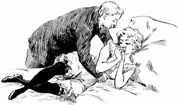 What
the Follies did was no less
than finally rid
America
of its post-Victorian hangover. No
other single force was stronger, or had more influence upon the emerging
American appetite for uncensored entertainment than this raw, cheap,
phony, artistically clumsy, nonsensical bit of sexual exploitation.
The Follies saw America well into the Roaring Twenties, with all that era’s bootleg whisky,
loose and flippant living, speakeasies, flapper girls, and easily gained
and lost fortunes. It was
one of the driving forces behind the movement to a freer and more open
society, which would not fully arrive for another 60 years. However, it was a start.
America was on the way out of the sexual doldrums, nicely led along by Ziegfield
and his beautiful, sleazy, cheap, wonderful chorus girls.
What
the Follies did was no less
than finally rid
America
of its post-Victorian hangover. No
other single force was stronger, or had more influence upon the emerging
American appetite for uncensored entertainment than this raw, cheap,
phony, artistically clumsy, nonsensical bit of sexual exploitation.
The Follies saw America well into the Roaring Twenties, with all that era’s bootleg whisky,
loose and flippant living, speakeasies, flapper girls, and easily gained
and lost fortunes. It was
one of the driving forces behind the movement to a freer and more open
society, which would not fully arrive for another 60 years. However, it was a start.
America was on the way out of the sexual doldrums, nicely led along by Ziegfield
and his beautiful, sleazy, cheap, wonderful chorus girls.
Babe Connors
It is difficult to ignore the contributions made to popular music by the
St. Louis
entrepreneur and businesswoman known around town as Babe Connors, and her equally
famous line of dancing girls. Babe
advertised these dancing girls as Creoles, but they were more likely
octoroons[13]
or some mixture thereof. They
danced in scanty outfits or in tights and always to a packed house.
The music was exciting and sexually suggestive. In the 1890’s it was generally felt that you couldn’t really
appreciate St. Louis unless you had been to Babe Connors’.[14]
Her girls were beautiful. They were very young and very light, of the Negro mixture known
as “pink skins.” She
usually kept eight or ten, and on less- occupied nights…would have the
girls dance in the nude, perhaps reluctantly, for Babe was never
all-out, preferring finesse, subtlety. Her favorite variant was to attire her girls in long skirts but
without underclothing. Thus
costumed, they would dance on a huge mirror.[15]
The most famous of all the singers at
Babe’s was Mama Lou, a short, gnarled, black African-American with a
powerful voice and a great command of American indigenous music. Mama Lou first introduced Ta-Ra-Ra-Boom-De-Ay,
probably from Paris or from the stage play. The Black Crook,
with it’s many lurid and salacious lyrics that have survived almost unchanged
in the school
yards, playgrounds, and back alleys of the country to this very day.
Every third grader chants the lyrics ad
nauseam, with variation but more often, using some of the original
verses:
Ta-Ra-Ra-Boom-De-Ay
Have you had yours today?
He laid me on the couch,
and baby’s on his way.
My mommy was surprised
To see my tummy rise,
Now baby’s on his way.
Ta-Ra-Ra-Boom-De-Ay.
Ta-Ra-Ra-Boom-De-Ay.
Ta-Ra-Ra-Boom-De-Ay.
Ta-Ra-Ra-Boom-De-Ay.
Ta-Ra-Ra-Boom-De-Ay.
Likewise, it was Mama Lou who first
sang The Bully Song, (arbitrarily considered as the first ragtime
song), whose
authorship was later ascribed to Charles Trevathan. Trevathan probably published what he heard while visiting
Babe’s, that is after he had appropriately sanitized the lyrics.
A third song attributed to the
redoubtable Mama Lou was Hot Time
in the Old Town Tonight, of Spanish American War fame, but
this too can be argued.
In 1897, Mama Lou left the employment
of Babe Connors to establish her own business. She turned out to be a good employer and maintained a close
relationship with her customers. Her
oftentimes outspoken and forward manner was the talk of the town. She was extraordinarily kind to her
girls, financially and with advice which she put into songs whose
scarlet lines which were said to put any page to flames. She was functional too.
An
old timer recalls this instance:
One night two stalwarts came to her
place [and] found it full of slender fops. “Git out o‘ here, you skinny boys!” screamed Mama Lou.
“Here comes a couple o’ men wiv juice in ‘em.”[16]
History is cruel to Babe Connors and
her talented performers, especially Mama Lou, because it
offers none of them sufficient recognition in the landscape of American
musical evolution. Perhaps
they were too far ahead of their time.
The 1890’s were still a time of sexual
repression. The adjudicators of righteousness still stood authoritative guard over
the mysteries of the bedroom and the secrets of life. Unfortunately the material that Babe promoted was too brash and
too forward for general consumption.
 Her
legacy lives on, from the rollicking Ta-Ra-Ra-Boom-De-Ay,
to the steady thump, thump of Hot
Time, to the bold and brash Bully
Song. She lives on in
our minds as perhaps the first bright light strong enough to shine forth
during that early 1890’s period to illuminate the way for others.
Her
legacy lives on, from the rollicking Ta-Ra-Ra-Boom-De-Ay,
to the steady thump, thump of Hot
Time, to the bold and brash Bully
Song. She lives on in
our minds as perhaps the first bright light strong enough to shine forth
during that early 1890’s period to illuminate the way for others.
Metaphor
A metaphor is the extension of the
meaning of a word so it can apply to something else that has similar
qualities. In early music
the word bedroom was strictly forbidden. Metaphors were developed for the bedroom, such as heaven,
paradise,
Eden, happiness,
loveland, and dreamland. Dreamland
was also a reference to the huge Coney Island
amusement park by that name and was also used to indicate having a
really great time.
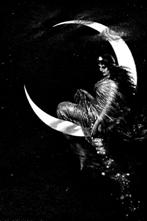 One
of the most common metaphors of the day was moon.
Its extensive use in song was not at all because it happened to
rhyme with June, spoon, croon, or tune, but rather because it was a
useful metaphor for sex. The word itself is unavoidably close to honeymoon
and spoon, the first of which describes sanctioned sex, and the second, illicit sexual gratification.
Moon also rhymes with June, traditionally a month of marriage,
rebirth, joy, and also, sex.
One
of the most common metaphors of the day was moon.
Its extensive use in song was not at all because it happened to
rhyme with June, spoon, croon, or tune, but rather because it was a
useful metaphor for sex. The word itself is unavoidably close to honeymoon
and spoon, the first of which describes sanctioned sex, and the second, illicit sexual gratification.
Moon also rhymes with June, traditionally a month of marriage,
rebirth, joy, and also, sex.
Those who belittle
the music of this era often cite excessive use of the moon metaphor.
However, this author firmly believes that the talented writers of
popular songs were well aware of the metaphorical potential of some
words and tended to use these words over and over for that very purpose. Here are
a few examples of the moon metaphor:
|
Song
Title
|
Use
of the moon metaphor
|
|
My
Sweetheart’s the Man in the Moon
|
Then
behind some dark cloud, Where no one is allow’d,
I’ll
make love to the man in the moon.
|
|
By
the Light of the Silvery Moon
|
By
the light of the silvery moon, I want to spoon, to my honey I’ll
croon loves tune. Honeymoon,
keep a shining in June, You’re silv’ry beams will bring love
dreams.
|
|
Ida,
Sweet as Apple Cider
|
Come
out in the silv’ry moonlight, and softly whisper…
|
|
Down
Among the Sheltering Palms
|
Moonlight
makes me lonely each night… where the sun goes down about eight.
How my love is burning, burning, burning…
|
|
I
Wonder Who’s Kissing Her Now
|
You
have kissed neath the moon while the world seemed in tune
|
|
Let
Me Call You Sweetheart
|
When
the silv’ry moonlight gleams
|
|
Moonlight Bay
|
As
we sing Love’s Old Sweet Song on Moonlight Bay
|
|
Put
Your Arms Around Me, Honey
|
And
the pale moon is shining from above
|
|
On
a Sunday Afternoon
|
Coming
home, starry dome with soft moonshine. Lovers kiss, oh what bliss, oh what joy divine.
|
|
Shine
on Harvest Moon
|
For
the moon refused to shine. Couple
sitting underneath a willow tree, for love they pine. (negative use of metaphor)
|
|
Sweetheart
of Sigma Chi
|
And
the moonlight beams on the girl of my dreams
|
|
Meet
Me Tonight in Dreamland
|
Meet
me tonight in Dreamland, under the silv’ry moon
|
|
Moonbeams
|
Moonbeams
shining soft above, Let me beg of you! Find the one I dearly love.
|
|
‘Neath
the Southern Moon
|
’Neath
The Southern moon, Oh, love so warm and tender
|
In modern music the use of
metaphor is no longer required because sexual activity can be openly
described, but even as recently as the 1960's it is used effectively in
the songs Happiness
is a Warm Gun and Muskrat Love,
both of which abound in powerful sexual metaphor. Yet
these songs never had to resort to more obvious sexual language. Such was the case with the moon
metaphor.
Ambiguous Words – Intentional
Confusion
Ambiguous words have
more than one meaning. Linguists
use ambiguous words when intentional confusion is desired. The richer a language is, the more shades of meaning it can give
to ideas, and in a way, the more mileage it can be gotten out of words.
But there are reasons for ambiguity.
English is a very rich language, boasting a word count well in excess of three million,
Multiple meaning words exist in the hundreds of
thousands. This makes the
English language incredibly good with fuzzy words, double meanings,
puns, confusion, and indefinite destinations (which may explain why we
have so many lawyers). Shakespeare
was absolute king of multiple-meaning words (puns), and his fine example
of double-meaning has generated a precedent continued to this
day. A quick look at an
English dictionary indicates that there are many multiple-meaning words.
Back then popular music thrived on ambiguous
words, and the most common area for use was in the description of
sexual activity. The power of wordplay became the saving medicine of early popular music
since about the only way the industry could circumvent strict
Victorian standards was by the clever use of double-meaning
words.
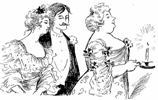 A
sexual experience, because of its personal nature and perhaps because of
the judgmental tendency of nonparticipants, cries out for euphemistic
description. A sexual encounter
can be referred to in many ways. For instance, couples made love, got together, fell, spooned,
chose the easy path, gave in to passion, enjoyed themselves, went the
limit, shot the moon, did the “hootchy-kootchy”, got some “nookie,”
or went to the moon, to Dreamland, to paradise, to heaven, to Loveland, or to Eden.
Women, on the other hand,
were laid, taken, made, had, done, deflowered, violated, tainted, or
sullied; or they fell, fell from grace, fell by the roadside or wayside,
became fallen angels or fallen ladies, lost their innocence, had a bad
experience or an unsettling experience, became mature, gained
experienced, or seen better days.
A
sexual experience, because of its personal nature and perhaps because of
the judgmental tendency of nonparticipants, cries out for euphemistic
description. A sexual encounter
can be referred to in many ways. For instance, couples made love, got together, fell, spooned,
chose the easy path, gave in to passion, enjoyed themselves, went the
limit, shot the moon, did the “hootchy-kootchy”, got some “nookie,”
or went to the moon, to Dreamland, to paradise, to heaven, to Loveland, or to Eden.
Women, on the other hand,
were laid, taken, made, had, done, deflowered, violated, tainted, or
sullied; or they fell, fell from grace, fell by the roadside or wayside,
became fallen angels or fallen ladies, lost their innocence, had a bad
experience or an unsettling experience, became mature, gained
experienced, or seen better days.
In a similar way, euphemisms abounded
in the description of prostitutes. They
were called daughters of Eve, daughters of sin, fallen angels, fallen
women, fallen souls, lost souls, bits of muslin, the muslin company[17],
Jezebels, cyprians, devil’s angels, angels of darkness, misguided
souls, demimonde[18],
black sheep, strays from the flock, strays from the path, those who lost
their way, misdirected souls, the restless throng, unfortunate souls, or
simply sinners. Wordplay has a universal character that spans a large percentage
of jokes, especially sexual in nature. American
comedy had continually employed double meaning as a
vehicle for humor and sex.
The most widely used, and perhaps the
safest, of all ambiguous words was the term making
love. In 1900, this
phrase meant exactly what it does today, that is, having physical
sex. It also came to
mean having an intimate and
romantic conversation. The
songwriter therefore was afforded a wonderful opportunity to use the
term making love without so
much as a second glance from the administrators of decency because it
could just as easily mean having
an intimate and romantic conversation. Since the morality police of the era
would have posterity believe sex did not exist, there was obviously no
polite way to say, “Let’s make love.”
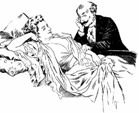 Other
than the biblical Let’s know
each other, which, I suspect, didn’t work all that well,
people needed to rely on additional
nonverbal communication to make themselves understood. Let’s say a young man takes a girl out on a date.
They go to a restaurant, then to a ballroom. They have a really good time and dance a lot, and if she is
willing, they go somewhere and he asks her to make love. In this case there would be little confusion.
If he’s not so sensitive, he could always be a little more
forthright like Chico Marx who, perhaps a bit too blatantly but
nevertheless politely, would ask a new chorus girl “Do you fuck?”[19]
which caused no confusion whatsoever.
The more direct words for sex were just as well known
and used in those days as they are today.
Other
than the biblical Let’s know
each other, which, I suspect, didn’t work all that well,
people needed to rely on additional
nonverbal communication to make themselves understood. Let’s say a young man takes a girl out on a date.
They go to a restaurant, then to a ballroom. They have a really good time and dance a lot, and if she is
willing, they go somewhere and he asks her to make love. In this case there would be little confusion.
If he’s not so sensitive, he could always be a little more
forthright like Chico Marx who, perhaps a bit too blatantly but
nevertheless politely, would ask a new chorus girl “Do you fuck?”[19]
which caused no confusion whatsoever.
The more direct words for sex were just as well known
and used in those days as they are today.
We do know a lot
of sex was going on, and there was no confusion about how to ask
for it, if accompanied by the right nonverbal signs. The only real confusion came later when historians tried to
determine if people were making
love or making love. Everybody
at that time seemed to know what they were doing. They were making love.
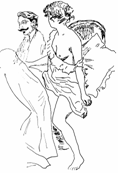 Other
confusing words are love and lover. In the 1910 song All
I Ask is Love, you must wonder what kind of love is being requested.
In the songs I Am Longing
for Someone to Love Me, I Love
the Ladies, or I Love You
Truly, again the question is, What kind of love do these songs refer
to? The answer may be in the
non-verbal communication that accompanied these songs, which we no longer have access to.
Even more telling is Jolson’s You
Made Me Love You, I Didn't Want to Do It. After hearing the song and watching Jolson on film, nobody
can seriously doubt the kind of love he was singing about. Nor can anybody really say that Love
me Tonight from The Vagabond
King is anything other than a one-night stand, unless they just
wanted to go to his tent and “have an intimate and romantic
conversation” all night. When
Cole Porter wrote Night and day, I
will spend my whole life making love to you, physical sex appears to
be what he had in mind.
Other
confusing words are love and lover. In the 1910 song All
I Ask is Love, you must wonder what kind of love is being requested.
In the songs I Am Longing
for Someone to Love Me, I Love
the Ladies, or I Love You
Truly, again the question is, What kind of love do these songs refer
to? The answer may be in the
non-verbal communication that accompanied these songs, which we no longer have access to.
Even more telling is Jolson’s You
Made Me Love You, I Didn't Want to Do It. After hearing the song and watching Jolson on film, nobody
can seriously doubt the kind of love he was singing about. Nor can anybody really say that Love
me Tonight from The Vagabond
King is anything other than a one-night stand, unless they just
wanted to go to his tent and “have an intimate and romantic
conversation” all night. When
Cole Porter wrote Night and day, I
will spend my whole life making love to you, physical sex appears to
be what he had in mind.
So popular music used a lot of the ambiguous qualities of American English to describe sexual
behavior. Songwriters
constantly teased the imagination of the public with metaphor, confusing
words, catchy little tidbits, phrases, and innuendoes, primarily because
it was a good way to sell copy. Berlin ’s Everybody’s Doing It
immediately suggests sex, and he was very good at that, although the
song is not referring to sex at all, but to a type of dance, The
Bear.
Here are a few really successful
song s of the day:
I wonder who’s kissing her now,
I wonder who’s teaching her how.[20]
I ain’t had no lovin’ since
January, February, June, or July.[21]
Cuddle up a little closer, lovey mine[22]
When poor Jonesy left the house each
morning
they would sit and spoon.
“Tell your tootsie who you love,”
Then softly he would croon[23]
These words and phrases were
purposely designed to be ambiguous. The songwriters intentionally used multiple meanings to allow a
sexual interpretation to be drawn from these songs, and I’m sure the
people who listened to and sang the music did exactly that. If a young man were to say to his girl “I ain’t had no lovin’
since January” and accompany this with the appropriate nonverbal eye
and hand movements, she had no doubt at all what he was talking about.
A songwriter had to determine how much double meaning could be
included in a song and how far the song could go, because a song’s
popularity often depended on just how good it was at expressing
ambiguous sexual ideas.
More Examples
As early as 1896 we find some good
examples of ambiguous sex. In
Sweet Rosie
O'Grady we notice lines that are quite suggestive of an ongoing or
steady sexual relationship,
because the word steady could mean a steady sexual affair.
Released at a time when public attitudes were still unaccustomed
to suggestions of this nature, this song is redeemed by the injection of
a social blessing (marriage), which could overcome any hint of untoward
premarital behavior.
She’s my steady lady
Most everyone knows.
And when we get married…[24]
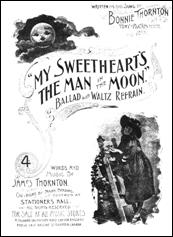
Some of the best examples of sexual ambiguity were found in the music of
Jim Thornton. He was one of the best in this area because he constantly tested
the limits of what could be tolerated. Many of the songs he wrote were intended for his wife Bonnie, the
vaudeville singer, and since that was the case, he was able to
get away with more daring song intimacy. In My Sweetheart’s the Man in the Moon, he does this well:
Then behind some dark cloud, Where no
one is allow’d,
I’ll make love to the man in the
moon.[25]
And later in the song, we even find a
clear phallic reference:
A sweet little Venus, we’ll fondle
between us,
He does this again in When
You Were Sweet Sixteen.
Come to me or my dream of love is
‘or.
I love you as I loved you
When you were sweet,
When you were sweet sixteen.[26]
In Good-bye,
My Lady Love, Joe Howard appears to use the word faithful in the same way that we use it today. From the lyrics it is hard to believe that the singer’s lady
love was anything less than intimate, especially when he continues to
ply her with terms of endearment and throw his heart all over the place
with his somewhat bombastic and inflated self-worth. His confidence indicates a lasting and therefore very close
relationship with his lady love, and the use of tender
love is probably about as intimate as you could get away with at
that time. But after all,
this was 1904 Broadway.
So you’ve gone away,
Because your heart has gone astray.
And you promised me,
That you would always faithful be.
Goodbye, my lady love.
Farewell, my turtle dove.
You are the idol and darling of my
life.
But someday you will come back to me,
And love me tenderly,
So good-bye, my lady love, goodbye.[27]
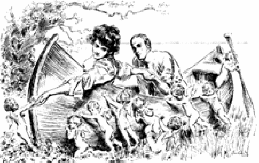
By
1909 a different perception of morality had settled into American life which
was reflected more and more in music. By
that time it seemed to be quite acceptable and commonplace to
sneak away with a girl and engage in kissing, heavy petting, and
whatever else might happen after they’ve gone up the river far enough.
Chaperonage was no longer in style, and popular music developed
lots of songs about young people running off alone together to
secluded locations. In Row, Row, Row, the young man rowed way up that river, and as he
rowed he became more and more interested in his lady companion. His rowing activity soon was to became another activity, most likely
kissing, petting, and
fondling. We can imagine
what happened when he got to the end of the river .
Row, row, row,
Way up the river he would row, row,
row,
A hug he’d give her then
He’d kiss her now and then,
They would kiss again, then
He would row, row, row[28]
There appears to be a change in
attitude about marriage also. In
Honeymoon, the man laments that it is over and now he is
married and unable to pursue other activities, perhaps other women.
Honeymoon, honeymoon,
Wonder why you left so soon.
Hearts are broken when you die.
Honeymoon.
Sadder maids, wiser men,
Watch you fade away and then,
No, you’ll ner’ return again,
Honeymoon.[29]
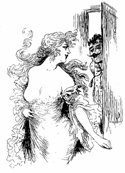 The Joy of Sex
The Joy of Sex
A lightheartedness had emerged in
music by 1909 and this seems to have
signaled the end of an older gloomy, resigned, stoical, sadder time.
It was the sheer joy of sex, nothing less, something entirely
alien to former beliefs. In the song Put Your Arms
Around Me Honey, Hold Me Tight there is a bubbling and enthusiasm
that had never really been seen before.
In my opinion, this was almost like the first Rock ‘n Roll
song and it came about 50 years too early.
Put your arms around me, honey, hold
me tight.
Huddle up and Cuddle up with all your
might.
Oh, Babe, Won’t you roll dem eyes,
Eyes that I just idolize.
When they look at me, my heart begins
to float,
Then it starts a rockin’ like a
motor boat.[30]
After 1915 and on into the 1920’s,
popular music continued a trend toward a more exuberant style of sexual
expression. Ambiguous wording was still
used but it did become harder to
interpret the meaning as anything other than sexual as in If
I could be With You.
If I could be with you I’d love you
strong.
If I could be with you I’d love you
long.
I want you to know that I wouldn’t
go,
Until I told you, honey that I love
you so.
If I could be with you one hour
tonight,
If I was free to do the things I
might,
I’m telling you true,
I’d be anything but blue,
If I could be with you.[31]
And:
Birds do it, bees do it.
Even educated fleas do it.
Let’s do it, lets fall in love.[32]
Code Words
Code words are not quite the same
thing as
metaphors or ambiguous words. Code
words have special use and meaning within a cultural context to signify
something quite specific and almost always sexual. These words added secret meaning and distinctive flavor to a
song, and the people who understood the code words felt like privileged
members of a club. A song became an
inside joke, a private message, and had a hidden meaning that was
fully understood and enjoyed only by those who belonged to the club.
Code words
were restricted to vaudeville. The
public at large did not usually understand or appreciate these special
words, which had to be presented almost always in blackface. But code words became unnecessary after 1915 because the public
had begun to accept songs containing other thinly disguised and
therefore rather easily distinguishable sexual references. There was no longer any need to camouflage meanings in some obscure
way. Lots of ambiguous words
were around that worked just as well as the
“secret” code words, and that almost everybody understood.
 From
its beginning, the music industry, vaudeville in particular, had used
code words for sex. In
blackface jargon, a tryst was a “spoon,” and sex was referred to as
“heat,” “warm,” and “fire” as in “she’s my warm baby”
and “warm enough for me” and “red hot.”[33]
The reverse was also true. A
girl who was not interested in sex was described as “cold,” as in
“you’re growing cold, cold, cold.” Although much of this blackface music did not make it into
popular music or had to be normalized into Standard English, the code
words were still an interesting aspect of musical development and some
words did pass firmly into popular use. In
this popular song the code words are easily understood:
From
its beginning, the music industry, vaudeville in particular, had used
code words for sex. In
blackface jargon, a tryst was a “spoon,” and sex was referred to as
“heat,” “warm,” and “fire” as in “she’s my warm baby”
and “warm enough for me” and “red hot.”[33]
The reverse was also true. A
girl who was not interested in sex was described as “cold,” as in
“you’re growing cold, cold, cold.” Although much of this blackface music did not make it into
popular music or had to be normalized into Standard English, the code
words were still an interesting aspect of musical development and some
words did pass firmly into popular use. In
this popular song the code words are easily understood:
Then again how’s the evening for a
spoon?
Call around tomorrow night,
We can then put out that fire in the
furnace.
My mama will sure be out of town.[34]
Today songwriters are free to write whatever they want to, and in the
most sexually explicit way they want to. In doing so it seems that a certain mystique has been
lost. A kind of finesse is
no longer there. Ambiguous
words, metaphor, and code words added an aspect that is often missing in
today’s clear, descriptive, sexually explicit music.
The Bird Cage Song
Von Tilzer finally broke
the sex barrier for popular music in 1900. Bird in a
Gilded Cage
was the first mainstream song to directly address a sexual issue. It was the first popular music piece to come out and actually
state what many songs before it had only hinted at. The “bird cage” opened new doors.
You may think she is happy and free
from care.
She’s not though she seems to be.
It’s sad when you think of her
wasted life,
For youth cannot mate with age,
And her beauty was sold for an old
man’s gold.
She’s a bird in a guilded cage.[35]
 Is
it morally reprehensible to marry for money, and is the consequence of
such action one’s own ruin? Harry
Von Tilzer, even though he was not able to identify the girl as a
mistress, which he wanted to do [36],
he still was able to suggest in the song that a relationship which is not
based on true love is unworkable, and ultimately self-destructive.
This notion is an old one, but it is given new vitality. In a modern version of this same theme, The
Eagles raise those questions again in Lyin’
Eyes. A woman who
marries for money will fail in her attempts to fill the emptiness within
herself, regardless of where her extramarital sexual escapades may take
her. The reason she is
unsuccessful is probably because her own value system is not capable of
recognizing true love, since it was that same value system that allowed
her to fall into this very situation to begin with. This is the message in Bird in a Gilded Cage, although the reason for the girl’s death
is unknown.
Is
it morally reprehensible to marry for money, and is the consequence of
such action one’s own ruin? Harry
Von Tilzer, even though he was not able to identify the girl as a
mistress, which he wanted to do [36],
he still was able to suggest in the song that a relationship which is not
based on true love is unworkable, and ultimately self-destructive.
This notion is an old one, but it is given new vitality. In a modern version of this same theme, The
Eagles raise those questions again in Lyin’
Eyes. A woman who
marries for money will fail in her attempts to fill the emptiness within
herself, regardless of where her extramarital sexual escapades may take
her. The reason she is
unsuccessful is probably because her own value system is not capable of
recognizing true love, since it was that same value system that allowed
her to fall into this very situation to begin with. This is the message in Bird in a Gilded Cage, although the reason for the girl’s death
is unknown.
This was a remarkable song!
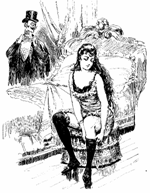
Two years later, in 1903, an
emboldened Von Tilzer produced another song called Mansion
of Aching Hearts [36a] which was actually passed off as a follow-up to
his “bird cage” song. It
is a story of the pain and loneliness experienced by a prostitute living
in a brothel. Von Tilzer was
again testing the waters, and the public enthusiastically accepted this
further calculated step into the uncharted reaches of musical freedom.
The song turned out to be a big hit, perhaps because of Von
Tilzer’s reputation or perhaps because the public wanted more sex in
its music. In either case,
by his clever use of double meaning, he was able to sell the song based
on its more innocent interpretation and because it was coming in on the
shirttails of his highly successful “bird cage” song.
She lives in a mansion of aching
hearts,
She’s one of a restless throng,
The diamonds that glitter around her
throat,
They speak of both sorrow and song;
The smile on her face is only a mask,
And many the tear that starts,
For sadder it seems, when of mother
she dreams,
In the mansion of aching hearts.[37]
Sexual Freedom
The newfound interest in sex may have
been due in some part to the wholesale movement of young people into
the workforce. The
independence and novelty of this independent lifestyle gave new
arrivals a sort of mischievous curiosity and abandon that they had never
experienced while living under the rules of a traditional
household. The entertainment
industry capitalized on this trend with
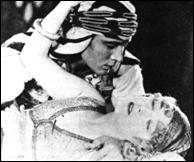 a
dramatic increase in the number of amusement parks, nickelodeons,
theaters, and movie houses. These
dark and poorly lighted movie houses, in particular, became known for
their encouragement of activities of a more intimate nature. For this reason the back row of seats at movies were generally
known as “lovers’ lane.”[38] Adding more fuel to the fire, movie themes of love and romance,
handsome sheiks, swashbuckling pirates, as well as intimate,
prolonged kissing scenes, reinforced a notion that movie houses were
perhaps intended for more than one kind of entertainment. Popular music was quick to take note of this and soon developed
songs reflecting the trend:
a
dramatic increase in the number of amusement parks, nickelodeons,
theaters, and movie houses. These
dark and poorly lighted movie houses, in particular, became known for
their encouragement of activities of a more intimate nature. For this reason the back row of seats at movies were generally
known as “lovers’ lane.”[38] Adding more fuel to the fire, movie themes of love and romance,
handsome sheiks, swashbuckling pirates, as well as intimate,
prolonged kissing scenes, reinforced a notion that movie houses were
perhaps intended for more than one kind of entertainment. Popular music was quick to take note of this and soon developed
songs reflecting the trend:
Take your girlie to the movies,
If you can’t make love at home.
Find a cozy corner where it’s nice
and dark.
Don’t catch influenza kissing in
the park.
Take your hint from Douglas
Fairbanks,
And make love scenes of your own.[39]
Sources of entertainment and mischief
could be easily found such as dance halls,
river cruises, and hotel rooms renting for a few hours at a
time, not to mention the vast amusement parks. Coney Island in 1909 was proud to possess three of the largest
amusement parks in the entire world,
Steeplechase
Park,
Luna Park, and the biggest one of all, Dreamland. Dreamland was presumably dedicated to “higher artistic
tastes” and was so big that it tended to draw the best crowds. Young couples could totally get lost among the many acres of
rides, roller-coasters, merry-go-rounds, concessions, bushes, hedges,
hideaways, coves, grottos, and abundant intimate little nooks and
crannies. It was an
excellent place to have fun, intimate or otherwise. If a young man took his date to Dreamland it was like a
weekend in Vegas.
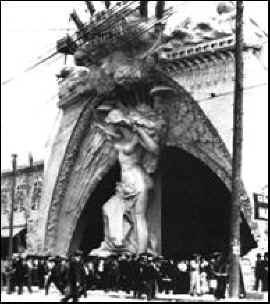 The biggest hit song of 1909 was Meet Me Tonight in Dreamland, which describes a surreptitious
rendezvous at Coney Island’s most famous amusement park.
The biggest hit song of 1909 was Meet Me Tonight in Dreamland, which describes a surreptitious
rendezvous at Coney Island’s most famous amusement park.
Meet me in Dreamland, sweet dreamy
Dreamland
There let my dreams come true.[40]
Then came the automobile. Hundreds of songs were written about people who made love, or
somehow attempted to do so, in their automobiles, that is until the car
broke down or something else happened. One of the most popular of all early car romance songs was done
in 1914 by Billy Murray. He
Had to Get Under, Get Out and Get Under, and Fix Up His Automobile.
While he was dying to cuddle and
squeeze.
But every minute, when he’d begin
it.
He had to get under,
Get out and get under,
And fix up his automobile.
A dozen times he’d try to hug and
kiss,
And then the darned old thing why it
would miss,
And so he had to get under…
Billionaire Johnson says to Johnny
one day.
“Your
little sweetheart don’t appreciate you.
I have a daughter who is hungry for
love,
She likes to ride, by the way.”
Johnny had visions of a million in
gold.
He took her riding in his little
auto.
But every time that he
Went to say “marry me,”
Was the old story again.
He had to get under,
Get out and get under,
and fix up his little machine…[41]
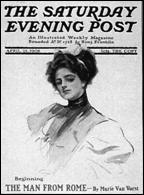 Another
area of sexual exploitation was the magazine, which was at this time
mightily coming of age. Often
the covers on magazines displayed incredibly attractive women dressed in
elegant and flowing ballroom attire. The song that well marked the end
of sheet music dominance in America described the predicament of a young man who fell hopelessly in love
with a Girl on the Magazine Cover.
Another
area of sexual exploitation was the magazine, which was at this time
mightily coming of age. Often
the covers on magazines displayed incredibly attractive women dressed in
elegant and flowing ballroom attire. The song that well marked the end
of sheet music dominance in America described the predicament of a young man who fell hopelessly in love
with a Girl on the Magazine Cover.
My head’s in dizzy whirl,
If I met a certain girl.
There isn’t another like her.
She’s a matchless pearl.
If I met the maid divine,
I’d do nothing else but pine,
Because I know she never would be mine.
The girl I love, is on a
magazine cover.
It seems they painted her just for me.
I’d fall in love, if I could ever discover
A little girl quite as nice as she.
If I could see her standing there,
I’d simply claim her and name her my queen.
And if she ever came, I would love her the same
As I love her on the cover of a
magazine.[42]
By 1909, the idea of sexual freedom
seemed commonplace in popular music, although this idea still had to use
metaphor and ambiguous wording. Ah, Sweet Mystery of Life has
been interpreted by some as the first description in American popular
music of an orgasmic experience.
For ‘tis love and love alone the
world is seeking,
And ‘tis love and love alone that
can repay![43]
1909 A Year of Revolution
In 1900, Harry Von Tilzer, at a high point
in his career, still had to submit to moral limitations of the times
and have his wayward prostitute married in the “bird cage” song, because
his publisher felt that adultery was not yet a marketable commodity.
Just nine years later, attitudes had sufficiently
shifted, so much so that the presentation of adulterous sexual topics was
commonplace and almost expected. Several
songs appeared that year containing references to such sexual
relationships. These songs
not only sold well but caused not even a stir among the established
minions of decency, who by then had pretty much abandoned hope of stopping
this overwhelming onslaught of what they considered immorality and
indecency. The
public perhaps realized that intimate sexual themes had always been
an expression of American romantic song tradition, in one way or
another. In this brief period from 1900 to 1909, the public standard of what was
morally acceptable
in music had changed so much that it was hardly recognizable as
the same music.
In that year Harry Von Tilzer wrote
an interesting song called I Love,
I Love, I Love My Wife, But Oh, You Kid. The song sold well and reflected a growing trend toward a
tolerance of wayward sexual behavior. Whiting, Snyder and Berlin
came up with My Wife’s Gone to
the Country (Hurrah! Hurrah!), in which a man rejoices when obtaining
a short time of freedom from his family, apparently to chase other
women. Call
Me Up Some Rainy Afternoon was another song that describes an open
invitation to intimate activities.
Also in 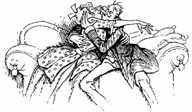 1909
Meet
Me Tonight in Dreamland blew the top off the charts, a song
which appears to refer to the amusement park at Coney Island, with its wild rides and raucous attractions, its huge and milling
crowds, and its boisterous barkers. Another interpretation which is suggested by the soft and flowing waltz
music
presents a place of quiet romance and intimate interaction. The subdued tone is a metaphor for a totally different type of
dreamland, like an amusement park in the bedroom.
1909
Meet
Me Tonight in Dreamland blew the top off the charts, a song
which appears to refer to the amusement park at Coney Island, with its wild rides and raucous attractions, its huge and milling
crowds, and its boisterous barkers. Another interpretation which is suggested by the soft and flowing waltz
music
presents a place of quiet romance and intimate interaction. The subdued tone is a metaphor for a totally different type of
dreamland, like an amusement park in the bedroom.
Other songs that year continued to
assault Victorian moral taboos,
anywhere from clothes to sex to private conduct in the presence of
ladies. In nine years this
country had gone completely topsy-turvy. By the Light of the Silvery
Moon, Heaven Will Protect the Working Girl, I Wonder Who’s Kissing Her
Now, and Ninette were smash hits that year.
The
following year saw more sexually expressive hits as Put
Your Arms Around Me, Honey, Hold Me Tight; All That I Ask is Love; Any
Little Girl, That's a-Nice Little Girl, Is the Right Little Girl for Me,
I’ve Got the Time, I've Got the Place, but It's Hard to Find the Girl,
Let Me Call You Sweetheart, Swing Me High, Swing Me Low, Two Little Love
Bees, and You Are the Ideal of My Dreams. This kind of open suggestiveness was not to be seen or tolerated
back in 1900. America
was set on a course of deliberate moral re-invention that would last
until the 1930’s.
America
had found Elvis.
The
Perfect Figure 36-26-38
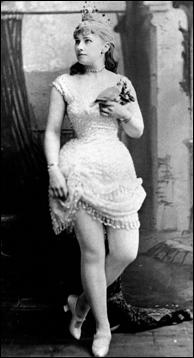 When we
see pictures of many stars and actresses from the late nineteenth
century, our first reaction is that they are slightly overweight, especially
around the hips. Over the
last 100 years, the model of the perfect women has gotten slimmer.
The acceptable size today is a taller woman, perhaps 5 feet 7
inches with a 35-24-34 proportion. This
is 6 inches taller but four inches smaller in the hips than the
desirable size for women in 1900--a noticeable and expected change for over 100 years.
The songs of the 1900’s rejoiced in the size of a lady’s
derriere, though many such songs remained respectfully and unobtrusively
in the vaudeville circuit. That's
Where my Money Goes made it into general popularity, and the
reference to battle ships is a generous compliment.
When we
see pictures of many stars and actresses from the late nineteenth
century, our first reaction is that they are slightly overweight, especially
around the hips. Over the
last 100 years, the model of the perfect women has gotten slimmer.
The acceptable size today is a taller woman, perhaps 5 feet 7
inches with a 35-24-34 proportion. This
is 6 inches taller but four inches smaller in the hips than the
desirable size for women in 1900--a noticeable and expected change for over 100 years.
The songs of the 1900’s rejoiced in the size of a lady’s
derriere, though many such songs remained respectfully and unobtrusively
in the vaudeville circuit. That's
Where my Money Goes made it into general popularity, and the
reference to battle ships is a generous compliment.
She’s got a pair of hips, just like
two battle ships,
I buy her everything to keep her in
style.
She wears silk underwear, I wear my
ankies[44]
bare.
Say boys, that’s where my money
goes.[45]
And her Golden Hair…
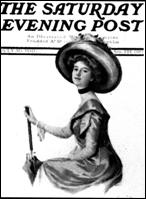 Women
let their hair grow quite long until 1920 when the bobbed look came along with flappers and wild dances.
By 1913 many women had started to let down a portion of their
hair, but before this time women wrapped their hair in a tight bun on
top of their heads. None of
those little wispy strands of hair hung down, for that was the sign of a
loose woman—a woman who had been doing something that made her hair
fall down. A respectable
woman kept her hair on the top of the head, where it was supposed to be.
Prepubescent girls could wear a portion of their hair down in
public, but only to shoulder length. Once a young lady reached puberty, she had to wear her hair up
like “decent” women. Before
1913 no respectable lady would be seen in public with any part of her
hair down on her shoulders. She
would let her hair down and comb it out only when she was in the privacy
of her own bedroom and ready to go to bed.
Women
let their hair grow quite long until 1920 when the bobbed look came along with flappers and wild dances.
By 1913 many women had started to let down a portion of their
hair, but before this time women wrapped their hair in a tight bun on
top of their heads. None of
those little wispy strands of hair hung down, for that was the sign of a
loose woman—a woman who had been doing something that made her hair
fall down. A respectable
woman kept her hair on the top of the head, where it was supposed to be.
Prepubescent girls could wear a portion of their hair down in
public, but only to shoulder length. Once a young lady reached puberty, she had to wear her hair up
like “decent” women. Before
1913 no respectable lady would be seen in public with any part of her
hair down on her shoulders. She
would let her hair down and comb it out only when she was in the privacy
of her own bedroom and ready to go to bed.
And
Her Golden Hair was Hanging Down Her Back
is unique because it describes the moral effects of big city life on an
impressionable young woman who comes to New York
from a small town. It
appears that she had her hair down because she didn’t know any better.
Anyone
coming from the country knew that in the city hair is kept up in a bun.
If we were to interpret the code word “to take a stroll” to
mean have sex, then the song suggests she was a ‘fallen angel” in
search of clientele. On the
other hand, it may have been intended to poke fun at the strict practice
of keeping the hair up in a bun.
When she landed in the station here
she took a little stroll,[46]
At ev’rything she wondered till she
lost her self control,
aid she, “New York is quite a village, ain’t it? Bless my soul!”
But oh, Jane does-n’t look the
same,
When she left the village she was
shy:
But alas! And alack! She’s gone
back,
with a naughty little twinkle in her
eye.[47]
“Golden Hair” was first published
in 1886 but only enjoyed limited popularity. Soon after being
cleaned up and re-published ten years later under the aegis of the indomitable
promoter Monroe Rosenfeld, it became a big hit. The importance of this song is that women did not let their hair
down in public, at least not until after 1913. Conversely, they did not sleep or have sex with their hair in a
bun--it was bad enough to have it uncomfortably rolled up all day.
Obviously, women let their hair down in the bedroom when they
were ready to go to bed and, presumably, have sex. Today the expression “letting your hair down” means to let go
and relax. In 1896 I think it meant
that you wanted to or were prepared to go to bed and have sex.
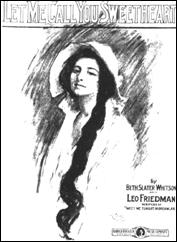 Prostitutes
usually wore all or a portion of their hair down, indicating their
trade, just as prostitutes today have characteristic clothing styles.
In 1910, the cover of Let Me call you Sweetheart featured a girl in very skimpy,
loose-fitting suggestive clothes with her long hair hanging down her
shoulders. Here is this
beautiful, misty, dreamy-eyed girl on the cover of the song sheet,
inviting sex before God and the world. It was a bold and remarkable statement, even for 1909.
The song was an absolute blockbuster.
Prostitutes
usually wore all or a portion of their hair down, indicating their
trade, just as prostitutes today have characteristic clothing styles.
In 1910, the cover of Let Me call you Sweetheart featured a girl in very skimpy,
loose-fitting suggestive clothes with her long hair hanging down her
shoulders. Here is this
beautiful, misty, dreamy-eyed girl on the cover of the song sheet,
inviting sex before God and the world. It was a bold and remarkable statement, even for 1909.
The song was an absolute blockbuster.
Let me call you sweetheart, I’m in
love with you.
Let me hear you whisper that you love
me too.
Keep the love light glowing in your
eyes so true.
Let me call you sweetheart, I’m in
love with you.[48]
Oh, My! The Moon is on Fire [49]
Much of successful early popular
music was by nature sexual.[50]
Moreover, the unusual combination of the rapid growth of popular
music in a society that was sexually repressed presented some
interesting problems and some interesting solutions as well.
An expectation was in the air when the new century came in.
For
well over 50 years the country had been gripped in the clutches of
piety, cloaked in a heavy vale of holiness, and smitten by a
sanctimonious spirituality. It
was a temporary condition of the belief structure at best, where babies were brought by storks, men
didn’t masturbate or have erections, and women didn’t menstruate or
perspire or even achieve sexual gratification. A zealous and
puritanical religion held sway over the population for these 50 years and dictated that things be
so. Sex had been legislated into nonexistence. Only “lost souls,” poor and destitute sinners,
because of their station in life or gender were
permitted to stray from the path of righteousness and indulge
in and enjoy the pleasures of the flesh.
 America has always been the land of opportunity and challenge.
If one wished to get ahead, to gain wealth through hard work and
careful investment, then the ranks of the middle class awaited and
opportunity was abundant. Along with this upward mobility came obligations and
moral responsibilities consisting of the same Victorian coda prescribed
and upheld by the powers-that-be. This set of rigorous beliefs denied the legitimacy of sexual enjoyment.
But
eventually the new middle class rejected these ideas.
America has always been the land of opportunity and challenge.
If one wished to get ahead, to gain wealth through hard work and
careful investment, then the ranks of the middle class awaited and
opportunity was abundant. Along with this upward mobility came obligations and
moral responsibilities consisting of the same Victorian coda prescribed
and upheld by the powers-that-be. This set of rigorous beliefs denied the legitimacy of sexual enjoyment.
But
eventually the new middle class rejected these ideas.
I suggest here that in the space of ten
years, the social tables had completely turned, and Tin Pan Alley had to
be responsible for some of this turning. Obscene music and lewd dancing had left the evil confines of houses of pleasure and vaudeville districts and invaded ballrooms
and dance halls. This music had
even insinuated itself into the very gut of
America, that is, parlors of the middle class. People
in saloons, barbershops, and department stores chanted the new tunes of Jim Thornton, Harry Von Tilzer, Ernest
Ball, and Irving Berlin. The
air was a-buzz with ragtime gals, sweetie pies,
and hootchy-kootchy songs of all verities and descriptions.
Even youth had been contaminated. All the while, the forces of the older order could only stand by, wringing their hands, as this flood of sexual openness swept
by them.
In 1900 the
“bird cage” song was the first to let the bird out of its cage.
Sexual attitudes began to shift, slowly at first and then more
quickly. 1915 witnessed an
even more dramatic display of moral openness with the advent of Jazz,
the Blues, the Fox Trot, to be followed in the 1920's by the Jitterbug,
Charleston, and the Black Bottom.
Things were happening so fast.
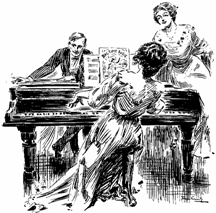 Jazz
was considered by the masters of morals to be a frightful, sinful,
degenerate noise that came from the self-styled Ninevah
of the South,
New Orleans, all the while holding hands with the twin denizens of evil out of
Chicago
and St. Louis. To add to the melee came
W.C. Handy, blowing Lucifer’s very own trumpet, the Blues. If that wasn’t enough to really upset things, Whitson and Friedman threw the country
into a sexual swoon with their immensely popular slow, erotic twin sex
waltzes Let Me Call You Sweetheart
and Meet Me Tonight in
Dreamland. It seemed
that there was no longer anything left untainted by the touch of that
evil shadow of darkness from the very bowels of hell called popular
music.
Jazz
was considered by the masters of morals to be a frightful, sinful,
degenerate noise that came from the self-styled Ninevah
of the South,
New Orleans, all the while holding hands with the twin denizens of evil out of
Chicago
and St. Louis. To add to the melee came
W.C. Handy, blowing Lucifer’s very own trumpet, the Blues. If that wasn’t enough to really upset things, Whitson and Friedman threw the country
into a sexual swoon with their immensely popular slow, erotic twin sex
waltzes Let Me Call You Sweetheart
and Meet Me Tonight in
Dreamland. It seemed
that there was no longer anything left untainted by the touch of that
evil shadow of darkness from the very bowels of hell called popular
music.
Social progress marches irrevocably
onward. Sometimes it is
slowed down by pressure from reactionary forces, but it must
inevitably catch up to its own pace. The onslaught of sexuality in the first decade of the twentieth
century seemed sudden, yet it was nothing more than an adjustment
after 50 years of standing still. Building
behind a giant dam that was destined to burst anyway, the water of a more
open morality had to rush forth in what seemed like a
torrent. The unnatural
repression of the fundamental and necessary sexual aspects of popular
music had itself, in effect, created the tidal wave. It had to come.
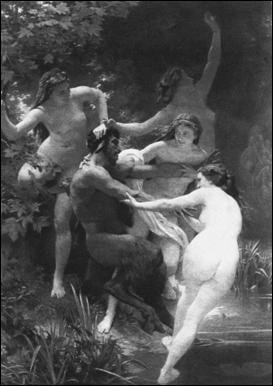
Nymphs and Satyr (1873)
by Adolf Bouguereau was the most
famous of all barroom paintings.
Here are some other links in this
article:
Origins
of Early Popular Music
Minstrelsy
Broadway
Vaudeville
Other sources
People
Growth - the First Baby Boom and it's effect
How
Dancing Helped Music
Women
and Early Music
Some
Early Songwriters
Some
Songs
The
Influence of the Piano
Recorded
Music
Sheet Music
Chronicles
1892-1900
Chronicles
1901-1915
Million
Sellers
[1]
A small cup of strong coffee usually served after the evening meal.
Here it represents an invitation to sexual indiscretions.
[2]
Edgar Smith & A. Baldwin Sloane, Heaven
Will Protect The Working Girl, 1909.
[3]
Stephen Foster, I Dream of
Jeanie with the Light Brown Hair, 1854.
[4]
John D’Emilio and Estelle B. Freedman, Intimate
Matters: A History of Sexuality in America
(New York: Harper & Row, Publishers, 1988), 199. Reprinted by permission of HarperCollins Publishers, Inc.
[5]
There was even an attempt to cover piano legs, but the movement
never got very far.
[6]
The novel Three Weeks,
written by Elinor Glyn, referred to sex as “it.” The scandalous book was banned in many areas.
[7]
Thomas P. Westendorf, I’ll
Take You Home Again, Cathleen, 1876.
[8]
Douglas Gilbert, Lost Chords:
The Diverting Story of American Popular Songs (New York: Cooper
Square Publishers, Inc., 1942), 214.
[9]
The best comparison we have today of this kind of singing can be
found in the styles of Janis Joplin and Bonnie Tyler.
[10]
Gilbert, 218.
[11]
Laurence Bergreen, As
Thousands Cheer: The Life of Irving Berlin (New York: Viking,
1990), 63.
[12]
The name given to Broadway because of all it’s bright white
lights.
[13]
Having one-eighth black ancestry.
[14]
Gilbert, 209.
[15]
Gilbert, 212.
[16]
Gilbert, 213.
[17]
The term may have come from the military. Prostitutes that accompanied armies were called the muslin
company.
[18]
That group of women who had lost the respect of society.
[19]
Jack Mingo, The Juicy Parts (New
York: Berkley Publishing Group, 1996), p 2.
[20]
Emerson Hough, Harold Orlab and Stanley Adams, I Wonder Who’s Kissing Her Now, 1908.
[21]
Jack Norworth, Shine On
Harvest Moon, 1908.
[22]
Karl Hoschna & Otto Harbach, Cuddle
Up a Little Closer, Baby Mine, 1908.
[23]
James Lucas & Harry Van Tilzer, I
Love, I Love, I Love my Wife But Oh You Kid, 1909.
[24]
Maude Nugent, Sweet Rosie
O’Grady, 1896.
[25]
James Thornton, My
Sweetheart’s the Man in the Moon, 1892.
[26]
James Thornton, When You were
Sweet Sixteen, 1898.
[27]
Joe Howard, Good-bye, My Lady
Love, 1904.
[28]
William Jerome & Jimmy Monaco, Row,
Row, Row, 1912.
[29]
Joe Howard, The Waning
Honeymoon, 1907.
[30]
Junie McCree & Albert Von Tilzer, Put
Your Arms Around Me, Honey, Hold Me Tight, 1910.
[31]
Henry Creamer, If I could Be
With You One Hour Tonight, 1926.
[32]
Ted Coehler & Harold Arlen, Let’s
Fall in Love, 1933.
[33]
Philip Furia, The Poets of Tin
Pan Alley (New York: Oxford University Press, 1992), 30.
[34]
Ada Jones & The American Quartet, Call
Me Up Some Rainy Afternoon, 1910.
[35]
Andrew Sterling & Harry Von Tilzer, Bird
in a Guilded Cage, 1900.
[36]
Douglas Gilbert, (Lost Chords,
Cooper Square Publishers, 1970, p.318) states that it was not Von
Tilzer but Bernstein, the publisher, who made Lamb change the
lyrics. "Why you've
written a song about a whore!” Said Bernstein.
[36a] I have the complete
sheet music here.
[37]
Arthur Lamb & Harry Von Tilzer, Mansion
of Aching Hearts, 1903.
[38]
D’Emilio & Freedman, 197.
[39]
Take Your Girlie to The Movies,
First recorded by Billy Murray, 1919, (Victor 18592).
[40]
Beath Whitson & Leo Friedman, Meet
Me Tonight in Dreamland, 1909.
[41]
Edgar Leslie & Maurice Abrahams, He’d
Have to Get Under, Get out and Get Under, to Fix up His Automobile,
1913.
[42]
Irving Berlin, Girl on the
Magazine Cover, 1915.
[43]
Rida Young & Victor Herbert, Ah,
Sweet Mystery of Life, 1910.
[44]
Feet, ankles.
[45]
Lilly & Daniels, That’s
Where My Money Goes, 1901.
[46]
The term “to take a stroll” or “to take a walk” was
frequently used as a code word for sex. It doesn’t fit too well here but later in the lyrics, it
becomes more apparent.
[47]
Monroe Rosenfeld & Felix McGlennon, And
Her Golden Hair Was Hanging Down Her Back, 1894.
[48]
Beath Whitson & Leo Freedman, Let
Me Call You Sweetheart, 1909.
[49]
Bryan & Fisher, Come
Josephine in My flying Machine, 1909.
[50]
A quick look at the million sellers in appendix I indicates that of
the 88 songs listed, 69, or almost 80 percent, deal strongly with
love and sex.
[51]
A biblical city known for it’s evil and sin.
[52]
I have my own record of May Irwin's
Frog Song.
 There is a misconception about that
period of time called the “gay nineties,” an apparently
joyous, light-hearted interlude from 1890 until 1910. In our minds’ eyes we see images of Victorian reserve and
emotional restraint, young ladies strolling in the sunlit park with
parasols in hand accompanied by handsome well-behaved beaus, properly
attired in well-groomed mustache and boater hat. In the cool evenings, moonbeams and soft starlight flicker
through the trees amid canoe rides and tender kisses.
The scent of fresh roses arise in the air, all the while
brass bands and roving quartets create sweet harmonies and rapturous
melodies:
There is a misconception about that
period of time called the “gay nineties,” an apparently
joyous, light-hearted interlude from 1890 until 1910. In our minds’ eyes we see images of Victorian reserve and
emotional restraint, young ladies strolling in the sunlit park with
parasols in hand accompanied by handsome well-behaved beaus, properly
attired in well-groomed mustache and boater hat. In the cool evenings, moonbeams and soft starlight flicker
through the trees amid canoe rides and tender kisses.
The scent of fresh roses arise in the air, all the while
brass bands and roving quartets create sweet harmonies and rapturous
melodies: This
means simply lots of sex. Until 1950, the ratio between the frequency of premarital sexual
activity and the number of illegitimate offspring had not changed very
much. At that point,
effective birth control--the pill--took over the task of regulating baby
production, affecting the long-standing statistical relationship between
premarital sexual activity and illegitimate births. Using this ratio, we can be pretty certain that more sex and free love
occurred around the turn
of the twentieth century than at any other period before 1950.
This
means simply lots of sex. Until 1950, the ratio between the frequency of premarital sexual
activity and the number of illegitimate offspring had not changed very
much. At that point,
effective birth control--the pill--took over the task of regulating baby
production, affecting the long-standing statistical relationship between
premarital sexual activity and illegitimate births. Using this ratio, we can be pretty certain that more sex and free love
occurred around the turn
of the twentieth century than at any other period before 1950. Just
about everything that was advertised to a fast-emerging middle class
from above demanded sexual restraint. This included dress, manners, public
comportment, social habits, boy-girl relationships, and the use of
chaperones. Ladies could not
expose even their ankles for fear of stirring passions and arousing carnal urges of
young men. The words “leg,” “breast,” “belly,” “woman,” and
other anatomically suggestive words were banished from polite
conversation. Other more
“suitable” words were used, such as lady or girl. Chicken had white meat instead of breast meat, dark meat instead
of legs.
Just
about everything that was advertised to a fast-emerging middle class
from above demanded sexual restraint. This included dress, manners, public
comportment, social habits, boy-girl relationships, and the use of
chaperones. Ladies could not
expose even their ankles for fear of stirring passions and arousing carnal urges of
young men. The words “leg,” “breast,” “belly,” “woman,” and
other anatomically suggestive words were banished from polite
conversation. Other more
“suitable” words were used, such as lady or girl. Chicken had white meat instead of breast meat, dark meat instead
of legs.



 By
1896 Anna Held hit upon fame in her own right with several songs. Still, she is most noted for her fabulously slim waist and her
reputation for requiring a daily milk bath, from which she supposedly
derived her beauty, passion, and singing abilities. Flo and Anna were finally married in 1896, and the marriage
lasted for a stormy 15 years. By
the time they did eventually divorce, both of them had, as you might
imagine, long-since abandoned any semblance of marital union and gone
back to their freewheeling and spontaneous ways of love.
By
1896 Anna Held hit upon fame in her own right with several songs. Still, she is most noted for her fabulously slim waist and her
reputation for requiring a daily milk bath, from which she supposedly
derived her beauty, passion, and singing abilities. Flo and Anna were finally married in 1896, and the marriage
lasted for a stormy 15 years. By
the time they did eventually divorce, both of them had, as you might
imagine, long-since abandoned any semblance of marital union and gone
back to their freewheeling and spontaneous ways of love. What
the Follies did was no less
than finally rid
America
of its post-Victorian hangover. No
other single force was stronger, or had more influence upon the emerging
American appetite for uncensored entertainment than this raw, cheap,
phony, artistically clumsy, nonsensical bit of sexual exploitation.
The Follies saw America well into the Roaring Twenties, with all that era’s bootleg whisky,
loose and flippant living, speakeasies, flapper girls, and easily gained
and lost fortunes. It was
one of the driving forces behind the movement to a freer and more open
society, which would not fully arrive for another 60 years. However, it was a start.
America was on the way out of the sexual doldrums, nicely led along by Ziegfield
and his beautiful, sleazy, cheap, wonderful chorus girls.
What
the Follies did was no less
than finally rid
America
of its post-Victorian hangover. No
other single force was stronger, or had more influence upon the emerging
American appetite for uncensored entertainment than this raw, cheap,
phony, artistically clumsy, nonsensical bit of sexual exploitation.
The Follies saw America well into the Roaring Twenties, with all that era’s bootleg whisky,
loose and flippant living, speakeasies, flapper girls, and easily gained
and lost fortunes. It was
one of the driving forces behind the movement to a freer and more open
society, which would not fully arrive for another 60 years. However, it was a start.
America was on the way out of the sexual doldrums, nicely led along by Ziegfield
and his beautiful, sleazy, cheap, wonderful chorus girls. Her
legacy lives on, from the rollicking
Her
legacy lives on, from the rollicking  One
of the most common metaphors of the day was moon.
Its extensive use in song was not at all because it happened to
rhyme with June, spoon, croon, or tune, but rather because it was a
useful metaphor for sex. The word itself is unavoidably close to honeymoon
and spoon, the first of which describes sanctioned sex, and the second, illicit sexual gratification.
Moon also rhymes with June, traditionally a month of marriage,
rebirth, joy, and also, sex.
One
of the most common metaphors of the day was moon.
Its extensive use in song was not at all because it happened to
rhyme with June, spoon, croon, or tune, but rather because it was a
useful metaphor for sex. The word itself is unavoidably close to honeymoon
and spoon, the first of which describes sanctioned sex, and the second, illicit sexual gratification.
Moon also rhymes with June, traditionally a month of marriage,
rebirth, joy, and also, sex. A
sexual experience, because of its personal nature and perhaps because of
the judgmental tendency of nonparticipants, cries out for euphemistic
description.
A
sexual experience, because of its personal nature and perhaps because of
the judgmental tendency of nonparticipants, cries out for euphemistic
description. Other
than the biblical Let’s know
each other, which, I suspect, didn’t work all that well,
people needed to rely on additional
nonverbal communication to make themselves understood. Let’s say a young man takes a girl out on a date.
They go to a restaurant, then to a ballroom. They have a really good time and dance a lot, and if she is
willing, they go somewhere and he asks her to make love. In this case there would be little confusion.
Other
than the biblical Let’s know
each other, which, I suspect, didn’t work all that well,
people needed to rely on additional
nonverbal communication to make themselves understood. Let’s say a young man takes a girl out on a date.
They go to a restaurant, then to a ballroom. They have a really good time and dance a lot, and if she is
willing, they go somewhere and he asks her to make love. In this case there would be little confusion. Other
confusing words are love and lover. In the 1910 song All
I Ask is Love, you must wonder what kind of love is being requested.
In the songs I Am Longing
for Someone to Love Me, I Love
the Ladies, or I Love You
Truly, again the question is, What kind of love do these songs refer
to? The answer may be in the
non-verbal communication that accompanied these songs, which we no longer have access to.
Even more telling is Jolson’s You
Made Me Love You, I Didn't Want to Do It. After hearing the song and watching Jolson on film, nobody
can seriously doubt the kind of love he was singing about. Nor can anybody really say that Love
me Tonight from The Vagabond
King is anything other than a one-night stand, unless they just
wanted to go to his tent and “have an intimate and romantic
conversation” all night. When
Cole Porter wrote Night and day, I
will spend my whole life making love to you, physical sex appears to
be what he had in mind.
Other
confusing words are love and lover. In the 1910 song All
I Ask is Love, you must wonder what kind of love is being requested.
In the songs I Am Longing
for Someone to Love Me, I Love
the Ladies, or I Love You
Truly, again the question is, What kind of love do these songs refer
to? The answer may be in the
non-verbal communication that accompanied these songs, which we no longer have access to.
Even more telling is Jolson’s You
Made Me Love You, I Didn't Want to Do It. After hearing the song and watching Jolson on film, nobody
can seriously doubt the kind of love he was singing about. Nor can anybody really say that Love
me Tonight from The Vagabond
King is anything other than a one-night stand, unless they just
wanted to go to his tent and “have an intimate and romantic
conversation” all night. When
Cole Porter wrote Night and day, I
will spend my whole life making love to you, physical sex appears to
be what he had in mind.

 The Joy of Sex
The Joy of Sex From
its beginning, the music industry, vaudeville in particular, had used
code words for sex. In
blackface jargon, a tryst was a “spoon,” and sex was referred to as
“heat,” “warm,” and “fire” as in “she’s my warm baby”
and “warm enough for me” and “red hot.”
From
its beginning, the music industry, vaudeville in particular, had used
code words for sex. In
blackface jargon, a tryst was a “spoon,” and sex was referred to as
“heat,” “warm,” and “fire” as in “she’s my warm baby”
and “warm enough for me” and “red hot.” Is
it morally reprehensible to marry for money, and is the consequence of
such action one’s own ruin? Harry
Von Tilzer, even though he was not able to identify the girl as a
mistress, which he wanted to do
Is
it morally reprehensible to marry for money, and is the consequence of
such action one’s own ruin? Harry
Von Tilzer, even though he was not able to identify the girl as a
mistress, which he wanted to do
 a
dramatic increase in the number of amusement parks, nickelodeons,
theaters, and movie houses. These
dark and poorly lighted movie houses, in particular, became known for
their encouragement of activities of a more intimate nature. For this reason the back row of seats at movies were generally
known as “lovers’ lane.”
a
dramatic increase in the number of amusement parks, nickelodeons,
theaters, and movie houses. These
dark and poorly lighted movie houses, in particular, became known for
their encouragement of activities of a more intimate nature. For this reason the back row of seats at movies were generally
known as “lovers’ lane.” The biggest hit song of 1909 was
The biggest hit song of 1909 was 
 Another
area of sexual exploitation was the magazine, which was at this time
mightily coming of age. Often
the covers on magazines displayed incredibly attractive women dressed in
elegant and flowing ballroom attire. The song that well marked the end
of sheet music dominance in America described the predicament of a young man who fell hopelessly in love
with a
Another
area of sexual exploitation was the magazine, which was at this time
mightily coming of age. Often
the covers on magazines displayed incredibly attractive women dressed in
elegant and flowing ballroom attire. The song that well marked the end
of sheet music dominance in America described the predicament of a young man who fell hopelessly in love
with a  1909
1909
 When we
see pictures of many stars and actresses from the late nineteenth
century, our first reaction is that they are slightly overweight, especially
around the hips. Over the
last 100 years, the model of the perfect women has gotten slimmer.
The acceptable size today is a taller woman, perhaps 5 feet 7
inches with a 35-24-34 proportion. This
is 6 inches taller but four inches smaller in the hips than the
desirable size for women in 1900--a noticeable and expected change for over 100 years.
The songs of the 1900’s rejoiced in the size of a lady’s
derriere, though many such songs remained respectfully and unobtrusively
in the vaudeville circuit.
When we
see pictures of many stars and actresses from the late nineteenth
century, our first reaction is that they are slightly overweight, especially
around the hips. Over the
last 100 years, the model of the perfect women has gotten slimmer.
The acceptable size today is a taller woman, perhaps 5 feet 7
inches with a 35-24-34 proportion. This
is 6 inches taller but four inches smaller in the hips than the
desirable size for women in 1900--a noticeable and expected change for over 100 years.
The songs of the 1900’s rejoiced in the size of a lady’s
derriere, though many such songs remained respectfully and unobtrusively
in the vaudeville circuit.  Women
let their hair grow quite long until 1920 when the bobbed look came along with flappers and wild dances.
By 1913 many women had started to let down a portion of their
hair, but before this time women wrapped their hair in a tight bun on
top of their heads. None of
those little wispy strands of hair hung down, for that was the sign of a
loose woman—a woman who had been doing something that made her hair
fall down. A respectable
woman kept her hair on the top of the head, where it was supposed to be.
Prepubescent girls could wear a portion of their hair down in
public, but only to shoulder length. Once a young lady reached puberty, she had to wear her hair up
like “decent” women. Before
1913 no respectable lady would be seen in public with any part of her
hair down on her shoulders. She
would let her hair down and comb it out only when she was in the privacy
of her own bedroom and ready to go to bed.
Women
let their hair grow quite long until 1920 when the bobbed look came along with flappers and wild dances.
By 1913 many women had started to let down a portion of their
hair, but before this time women wrapped their hair in a tight bun on
top of their heads. None of
those little wispy strands of hair hung down, for that was the sign of a
loose woman—a woman who had been doing something that made her hair
fall down. A respectable
woman kept her hair on the top of the head, where it was supposed to be.
Prepubescent girls could wear a portion of their hair down in
public, but only to shoulder length. Once a young lady reached puberty, she had to wear her hair up
like “decent” women. Before
1913 no respectable lady would be seen in public with any part of her
hair down on her shoulders. She
would let her hair down and comb it out only when she was in the privacy
of her own bedroom and ready to go to bed. Prostitutes
usually wore all or a portion of their hair down, indicating their
trade, just as prostitutes today have characteristic clothing styles.
In 1910, the cover of
Prostitutes
usually wore all or a portion of their hair down, indicating their
trade, just as prostitutes today have characteristic clothing styles.
In 1910, the cover of  America has always been the land of opportunity and challenge.
If one wished to get ahead, to gain wealth through hard work and
careful investment, then the ranks of the middle class awaited and
opportunity was abundant. Along with this upward mobility came obligations and
moral responsibilities consisting of the same Victorian coda prescribed
and upheld by the powers-that-be. This set of rigorous beliefs denied the legitimacy of sexual enjoyment.
But
eventually the new middle class rejected these ideas.
America has always been the land of opportunity and challenge.
If one wished to get ahead, to gain wealth through hard work and
careful investment, then the ranks of the middle class awaited and
opportunity was abundant. Along with this upward mobility came obligations and
moral responsibilities consisting of the same Victorian coda prescribed
and upheld by the powers-that-be. This set of rigorous beliefs denied the legitimacy of sexual enjoyment.
But
eventually the new middle class rejected these ideas. Jazz
was considered by the masters of morals to be a frightful, sinful,
degenerate noise that came from the self-styled Ninevah
of the South,
New Orleans, all the while holding hands with the twin denizens of evil out of
Chicago
and St. Louis. To add to the melee came
W.C. Handy, blowing Lucifer’s very own trumpet, the Blues. If that wasn’t enough to really upset things, Whitson and Friedman threw the country
into a sexual swoon with their immensely popular slow, erotic twin sex
waltzes Let Me Call You Sweetheart
and
Jazz
was considered by the masters of morals to be a frightful, sinful,
degenerate noise that came from the self-styled Ninevah
of the South,
New Orleans, all the while holding hands with the twin denizens of evil out of
Chicago
and St. Louis. To add to the melee came
W.C. Handy, blowing Lucifer’s very own trumpet, the Blues. If that wasn’t enough to really upset things, Whitson and Friedman threw the country
into a sexual swoon with their immensely popular slow, erotic twin sex
waltzes Let Me Call You Sweetheart
and 